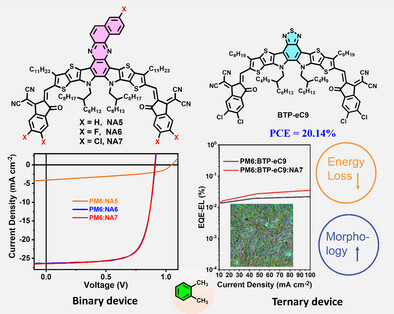
近日,深圳大学杨楚罗团队报道了卤化工程接收器在碳氢溶剂处理的OSC中实现了20.14%的效率:从二元权衡到三元协同的激子和能量损失管理。这一研究成果于2025年9月1日发表在《德国应用化学》杂志上。
卤化是通过调整分子包装、能级和电荷动力学来提高有机太阳能电池(OSCs)性能的关键策略。
研究组报道了三个新的苯并[a]非那嗪核小分子受体,即NA5, NA6和NA7,并系统地评价了它们在邻二甲苯加工的二元和三元OSC中的光伏性质。卤化作用增强了分子间的相互作用,提高了载流子的迁移率,促进了激子的解离,使二元器件效率从2% (NA5)显著提高到17%以上(NA6, NA7)。然而,卤化也会增加电荷转移态特征,从而导致更高的非辐射复合和能量损失。尽管存在这样的缺点,但卤化所带来的电荷分离驱动力的增强和形态秩序的改善超过了能量损失的负面影响。
值得注意的是,在PM6:BTP-eC9三元体系中加入NA7优化了共混物形态,抑制了非辐射复合,并实现了创纪录的20.14%(认证为19.93%)的功率转换效率,这是用碳氢溶剂加工的OSCs的最高效率。这些发现强调了卤化在调节器件能量学的有益和有害方面的双重作用,为高性能,环境友好型OSCs的分子设计策略提供了新的见解。
附:英文原文
Title: Halogenation-Engineered Acceptor Enables 20.14% Efficiency in Hydrocarbon-Solvent Processed OSCs: From Binary Trade-Offs to Ternary Synergy in Exciton and Energy Loss Management
Author: Jun Zhang, Weifei Wei, Zhenghui Luo, Zhanxiang Chen, Ruijie Ma, Mengyang Wang, Yongmin Luo, Yi Chan, Zhaozhao Bi, Yao Li, Jiaying Wu, Qunping Fan, Wei Ma, Gang Li, Chuluo Yang
Issue&Volume: 2025-09-01
Abstract: Halogenation emerges as a key strategy to enhance the performance of organic solar cells (OSCs) by tuning molecular packing, energy levels, and charge dynamics. Here, we report three new benzo[a]phenazine-core small-molecule acceptors, namely NA5, NA6, and NA7, and systematically evaluate their photovoltaic properties in o-xylene-processed binary and ternary OSCs. Halogenation significantly strengthens intermolecular interactions, improves charge carrier mobility, and facilitates exciton dissociation, leading to a remarkable increase in binary device efficiencies from ~2% (NA5) to over 17% (NA6, NA7). However, halogenation also increases charge-transfer state character, which can induce higher nonradiative recombination and energy loss. Despite this drawback, the enhanced driving force for charge separation and improved morphological order enabled by halogenation outweigh the negative effects on energy loss. Notably, incorporation of NA7 into the PM6:BTP-eC9 ternary system optimizes blend morphology, suppresses nonradiative recombination, and thus achieves a record power conversion efficiency of 20.14% (certified 19.93%)—the highest reported for OSCs processed with hydrocarbon solvents. These findings highlight the dual role of halogenation in modulating both beneficial and detrimental aspects of device energetics, providing new insights into molecular design strategies for high-performance, environmental-friendly OSCs.
DOI: 10.1002/anie.202512237
Source: https://onlinelibrary.wiley.com/doi/10.1002/anie.202512237
Angewandte Chemie:《德国应用化学》,创刊于1887年。隶属于德国化学会,最新IF:16.823
官方网址:https://onlinelibrary.wiley.com/journal/15213773
投稿链接:https://www.editorialmanager.com/anie/default.aspx
